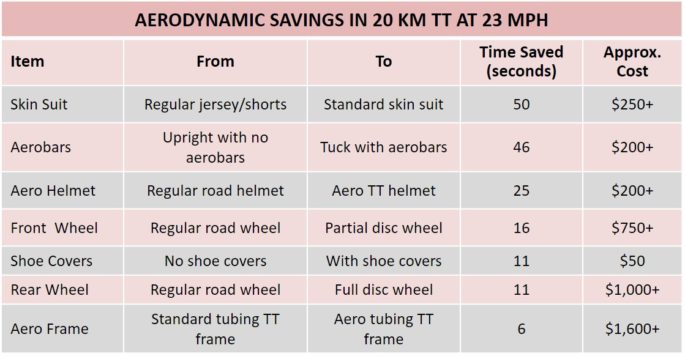Tip #16: What gear do you need to compete?
Obesity levels for the senior population in the U.S. are now over 40 percent. If you are a former high school/college/post-college athlete who has been on the couch for the past 20-30+ years, this series of twice-monthly (1st and 15th of the month) tips will show you how to resume an active lifestyle.
Fortunately, numerous studies have confirmed that it is never too late to resume an active lifestyle. I will show you how to reduce your fitness age, a more reliable indicator of longevity than your BMI, by 20+ years over the next 12-24 months. You will definitely be healthier, happier, and an inspiration for your family, friends, and colleagues. What’s better than that?
What gear do you need to compete?
 If you can afford it, and have raised your fitness level to the point that you have a chance at a victory or podium finish, then spend the money for a TT race bike and aero wheels, which will cost over $3,000. There is another level of gear beyond this chart: shorter crank arms and ceramic bearings for your wheels and bottom bracket. They will cost another $3,500.
If you can afford it, and have raised your fitness level to the point that you have a chance at a victory or podium finish, then spend the money for a TT race bike and aero wheels, which will cost over $3,000. There is another level of gear beyond this chart: shorter crank arms and ceramic bearings for your wheels and bottom bracket. They will cost another $3,500.
Why would you want to spend this amount of money for ever smaller amounts of time saved? It is all about the level of competition you’re facing. At the local or state level, your competitors will have a mix of the best aerodynamic gear. At the regional, national, or world championship level, all of your competitors will have all of the best gear on the market.
In the previous tip, I mentioned the margin of victory in a masters national 20 km time trial championship race. At 26.07 mph average, the difference between first place (0:28:10:1) and second place (0:28:10.8) was only 0.7 of a second. And the time gap between the first and 10th place (0:29:08/25.21 mph) finisher was only 58 seconds. They all had the best gear available. The difference in speed came down to training.
What have I learned?
Then, after a few years and 25 races, I bought aero wheels: HED front and full disc rear wheels for over $2,000. Meanwhile, I realized that the P1 was not the right bike for my body and upgraded to a Specialized Shiv, a state-of-the-art triathlon bike, costing roughly $3,000. This has been my basic gear for the past 70+ races.
Just before returning to live racing again, I upgraded my Shiv with shorter crank arms (160 mm vs 172.5 mm), ceramic speed bearings (increase of 10-14 watts), and high-angle aerobars. We’ll see how much faster I’ve become along with the change in training focus from heart rate to power.
Any questions?
Tip #17 Preview: How do you train like an athlete again?
